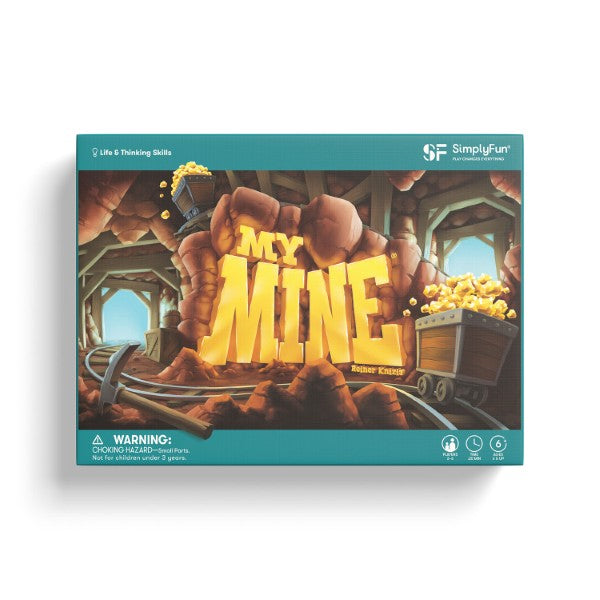
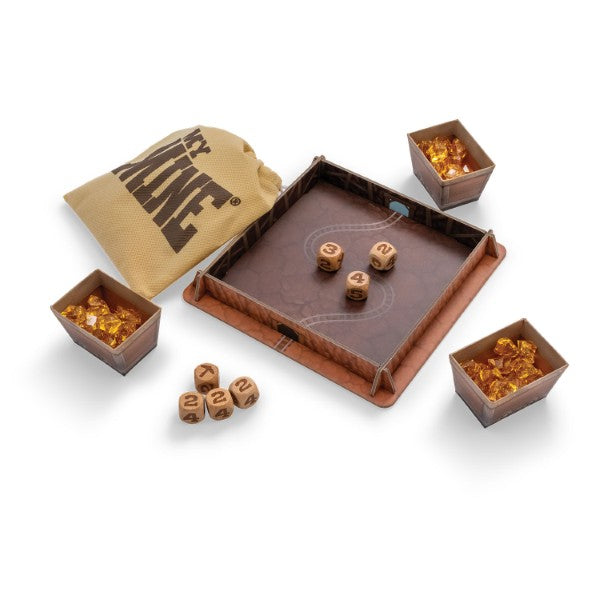
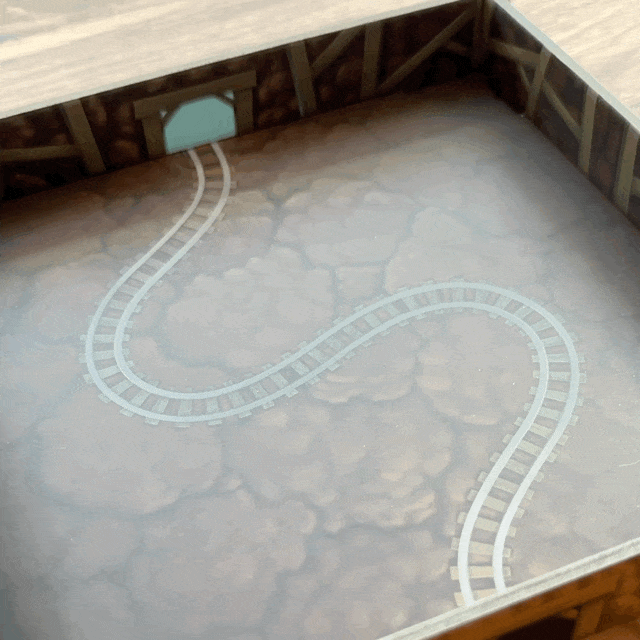

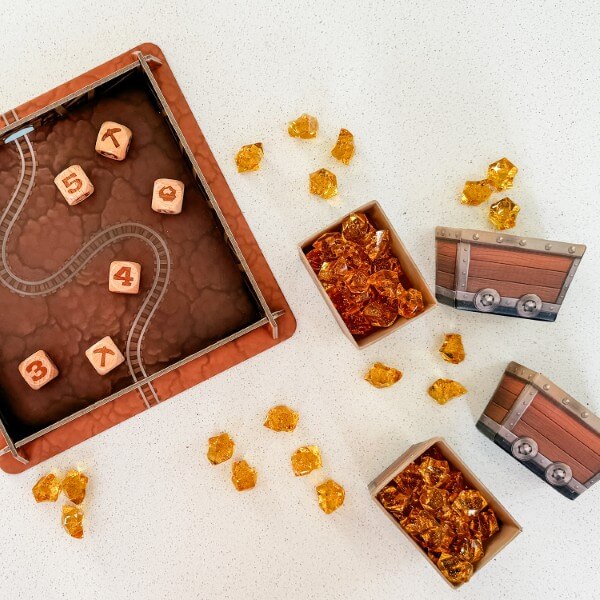


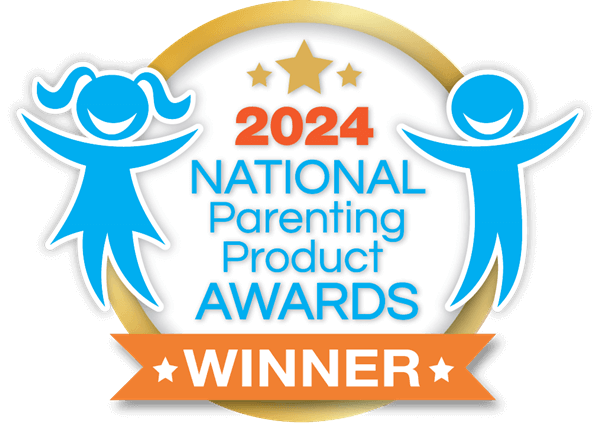
Collapsible content
You can play My Mine with 2-6 players, ages 6 and up!
My Mine is great for practicing Decision Making as players choose which dice to set aside, where to claim their nuggets from, and whether to continue to reroll and risk losing what they have already set aside.
My Mine also helps develop Predicting skills as players use analysis and observation when thinking about how many dice they will have left to roll and what the chances are that they will get the outcome they want.
Place the dice tray with the dice in the middle of the play area where everyone can reach.
Place all 77 gold nuggets in the storage bag, and set it to the side of the dice tray.
Give each player a minecart.
Choose a starting player by having each player roll all seven dice. Add up any numbers shown. The highest roller goes first and play continues clockwise.
This is a game of risk and reward. Players roll the dice and try to collect as many gold nuggets as they can. But if you get too greedy, you may lose it all.
Your turn consists of two actions: Staking Your Claim with the dice, and then Collecting Your Gold.
Action One: Staking Your Claim
Start your turn by rolling all seven dice into the dice tray, hoping to set aside a combination of dice that will let you collect gold nuggets. You can reroll the remaining dice as many times as you want on your turn, as long as you can set aside at least one die after each roll. Any dice set aside should be placed outside the dice tray, away from any rerolls.
You are allowed to set aside the following on any roll:
• One or more dice showing a gold nugget
• One or more dice showing the pickaxe symbol
• A group of three or more dice showing the same number
Note: In the rare instance where your first roll does not allow you to set aside any dice, you may roll again.
Adding to number groups: Normally, you can only set aside number dice as a group of three or more. However, if you have already set aside a group of number dice, you can add to that group even if you roll less than three dice of the same number on rerolls. You can set aside just one or two matching dice, allowing you to continue rolling when options are limited. If you manage to increase the group to six or seven dice, you can split those dice into two groups to claim even more gold . Dice set aside cannot be added back into the roll later in a turn, so consider your choices!
At any point after your first roll, you may choose to stop and collect your claim based on the dice you have set aside. Give it some thought. If you choose to reroll and are unable to set aside any more dice, you give up all the dice you previously set aside and collect no nuggets: it is the next player’s turn. If you choose to stop, move on to Action Two: Collecting Your Gold.
Action Two: Collecting Your Gold
The following chart shows how much gold to collect from the bag for the dice you have set aside during your turn. Each group of numbered dice earns gold nuggets equal to the number shown, not the sum of the dice rolled.
• Collect one nugget for each die showing a gold nugget.
• For each group of three or more nuggets showing the same number, collect nuggets equal to the number shown. (Not the total number of dice)
Collecting Gold from Another Player
All dice showing the pickaxe symbol have a value of zero. However, if you can set aside three or more pickaxes during your turn, you can choose to take all your earned nuggets from another player. Simply collect your gold nuggets from another player’s minecart instead of the bag. If that player has less gold than what you earned during your turn, you only receive what that player has and do not take the remainder from the bag.
If you are successful in setting aside all seven dice during your turn, claim your nuggets plus an additional three bonus nuggets. These bonus nuggets are always pulled from the bag, not another player. For additional examples, you can always refer to the rules.
After you have claimed your gold nuggets, either from the bag or from another player, your turn is over. Place all your claimed nuggets in your minecart for safekeeping. Play proceeds clockwise and it is the next player’s turn.
Losing Your Claim
If you are unable to set aside any dice after a roll, your turn is over and you give up any claim from the dice set aside on that turn. Play proceeds clockwise and it is the next player’s turn.
The game ends when a player removes the last gold nugget from the bag. If there are not enough nuggets available to fill their claim, the player receives only what is left.
All players then count up all the nuggets in their minecarts and the player with the most gold nuggets wins! In the case of a tie, the players share the victory.
Roll the dice and stake your claim in SimplyFun’s My Mine.


Core Standard*: Math
- Counting and Cardinality
- Count to tell the number of objects. Grade Level K
- Operations and Algebraic Thinking
- Add and subtract within 20. Grade Levels 1st, 2nd


Explore
What Does Child Do To Use Skill In The Game?
Players look at the rolled dice to evaluate whether they can score gold nuggets, take gold nuggets from another player, or lose their claim.
How Parents Can Assist Learning
No special adult support required.
Learning Implications and Educator Support
No special adult support required.
Determine
What Does Child Do To Use Skill In The Game?
Players combine dice together to determine which is the best combination for scoring, and determine whether to roll again or complete their turn by taking the appropriate amount of gold nuggets.
How Parents Can Assist Learning
To help children develop patience and precision, encourage them to look closely at the dice in order to ensure they are scoring properly.Educators can also work with children on determining whether to take gold nuggets from opponents or from the Cloth Bag when they accumulate 3 or more Mine dice. Ask the child to talk about the advantages or disadvantages of either option. Questions could include "How will another player react if you take their gold nuggets?" or "Is another player have more gold nuggets than you?"
Learning Implications and Educator Support
To help children develop patience and precision, encourage them to look closely at the dice in order to ensure they are scoring properly.Educators can also work with children on determining whether to take gold nuggets from opponents or from the Cloth Bag when they accumulate 3 or more Mine dice. Ask the child to talk about the advantages or disadvantages of either option. Questions could include "How will another player react if you take their gold nuggets?" or "Is another player have more gold nuggets than you?"
Compare
What Does Child Do To Use Skill In The Game?
Players compare the different dice and scoring combinations. They also compare their score to opponents as part of planning and strategizing choices.
How Parents Can Assist Learning
After rolling encourage children to move dice around into different arrangements in order to evaluate each scoring option.Additionally, remind them to look at the cumulative scores of their opponents which can influence their risk-reward assessment of whether to roll again, stop rolling or, if possible, try to get 3 or more Mine dice in order to take gold nuggets from another player.
Young children may be inclined to act impulsively. Encourage children to think about what might happen with another roll, whether to take gold nuggets from the Cloth Bag or another player, etc.
Learning Implications and Educator Support
After rolling encourage children to move dice around into different arrangements in order to evaluate each scoring option.Additionally, remind them to look at the cumulative scores of their opponents which can influence their risk-reward assessment of whether to roll again, stop rolling or, if possible, try to get 3 or more Mine dice in order to take gold nuggets from another player.
Remember
What Does Child Do To Use Skill In The Game?
Players need to remember the meaning of each die and the value for combinations of dice. After playing numerous times, players will begin to remember prior decisions and outcomes. This will influence their ability to make risk-reward analysis on current rolls of the dice.
How Parents Can Assist Learning
If you see children in a situation that is similar to a prior game, remind them what happened last time. This will help the child think more thoroughly and reduce impulsivity.
Learning Implications and Educator Support
If you see children in a situation that is similar to a prior game, remind them what happened last time. This will help the child think more thoroughly and reduce impulsivity.
Predict
What Does Child Do To Use Skill In The Game?
Predicting is essential to My Mine. On every turn after the initial roll, the player rolling the dice is predicting what (Mine, number or gold nugget) may be rolled next in order to decide whether to make the roll or end the turn.
How Parents Can Assist Learning
Parents can prompt children to practice predicting by asking them to think how many dice they will have left to throw and what chances are they will throw what they want. They can also make predictions about what the opponent will do after they have their first throw.
Learning Implications and Educator Support
Predicting involves skills like analysis, observation, empathy and interpretation. Also, children need to learn how to change perspective, imagining being their opponent, in order to have optimal predicting skills. Educators can prompt children to practice predicting by asking them to think about what the opponent will do on their next turn.
Playing My Mine requires analyzing the odds of rolling scoring dice and whether the potential additional score is worth the risk of a losing your claim (a non-scoring roll that eliminates all your points for that turn). If a child accumulates 3 or more Mine dice, there is additional risk-reward analysis in deciding whether to take gold nuggets from the Cloth Bag or an opponent. All of this risk-reward analysis and choice-making is driven by making hypotheses and predictions, which is foundational for strategic thinking.
Experiment
What Does Child Do To Use Skill In The Game?
Players may experiment with more or less risky strategies. For example, a more aggressive strategy would involve taking gold nuggets from opponents and rolling when there is low probability to roll successfully (ex: rolling 1 die to get a Mine).
How Parents Can Assist Learning
No special parent support required.
Learning Implications and Educator Support
No special parent support required.
Practice
What Does Child Do To Use Skill In The Game?
The more they play, the more players will increase their understanding of the odds of successfully rolling scoring dice on a turn.
How Parents Can Assist Learning
The more proficient children become in understanding the odds and assessing the reaction of other players, the more accurate their risk-reward analysis and choices will be.
Learning Implications and Educator Support
The more proficient children become in understanding the odds and assessing the reaction of other players, the more accurate their risk-reward analysis and choices will be.
Solve
What Does Child Do To Use Skill In The Game?
Players rely heavily on prediction and analysis to solve the goal of the game, accumulating the most points. On every turn after the initial roll, the player rolling the dice is predicting what (Mine, number or gold nugget) may be rolled next in order to decide whether to make the roll or end the turn. They also resolve each turn by adding up the scores on the dice and taking the corresponding number of gold nuggets.
How Parents Can Assist Learning
Encourage children to stop and think before rolling again. This will help reduce impulsivity and increase their ability to consider the risk-reward of rolling versus stopping their turn with the current points they have accumulated.Also, children will need to pay attention to opponents as they are gain or lose gold nuggets. Children need to consider this information to make decisions on whether to take gold nuggets from an opponent.
Learning Implications and Educator Support
Predicting involves skills like analysis, observation, empathy and interpretation. Also, children need to learn how to change perspective, imagining being their opponent, in order to have optimal predicting skills. Educators can prompt children to practice predicting by asking them to think about what the opponent will do on their next turn.
Playing My Mine requires analyzing the odds of rolling scoring dice and whether the potential additional score is worth the risk of a losing your claim (a non-scoring roll that eliminates all your points for that turn). If a child accumulates 3 or more Mine dice, there is additional risk-reward analysis in deciding whether to take gold nuggets from the Cloth Bag or an opponent. All of this risk-reward analysis and choice-making is driven by making hypotheses and predictions, which is foundational for strategic thinking.
Review
What Does Child Do To Use Skill In The Game?
Children may voluntarily analyze their risk assessment and decision making during and after the game.
How Parents Can Assist Learning
If children do not spontaneously share their analysis, encourage them to discuss the results of different decisions they made. Adults can model this for them by sharing what happened as a result of their decisions about strategies.
Learning Implications and Educator Support
If children do not spontaneously share their analysis, encourage them to discuss the results of different decisions they made. Adults can model this for them by sharing what happened as a result of their decisions about strategies.
Demonstrate
What Does Child Do To Use Skill In The Game?
Players demonstrate by verbally adding up the points on a turn and tracking the cumulative scores.
How Parents Can Assist Learning
No special parent support required.
Learning Implications and Educator Support
No special parent support required.
*Data compiled from CCSSI ELA Standards, WA Science Standards, and Washington Social Studies Standards


Cognitive
Suggestions for How to Modify Play Experience
My Mine is a good game for helping children to match numbers and symbols. If children recognize early number symbols they should be able to play.
Adults or other players may need to help children with cognitive delays think about the potential risk or reward of throwing again. Explain that the fewer the dice left to throw, the greater the chance they will not get a helpful die and may lose their earnings and their turn.
Let children take one nugget for each matching number. This provides an incentive for the child to continue to match numbers and allows them to add to their score even when their throws do not result in a three-number roll.
Communication
Suggestions for How to Modify Play Experience
No communication is needed to play, but it is helpful if children can have a conversation to discuss their score and whether or not to throw again. This requires comprehension of the directions as well as risk/reward chances.
Sensorimotor
Suggestions for How to Modify Play Experience
Children with sensorimotor delays may benefit from having a dice cup or plastic glass to control the throw of the dice.
Other players can help separate the dice if needed, depending on what the child says they want set aside.
Social Emotional/Behavioral
Suggestions for How to Modify Play Experience
Children who are impulsive may want to keep throwing the dice until they lose their turn. They may need verbal prompting to help them think about the probabilities of the results of each throw. Encourage them to stop and think about how many dice are left and what they might come up with in the next throw.
Some children may only be interested in their own turn and thus lose interest when another player continues to roll the dice for their turn. Involve the child by discussing the results of each roll of the other player and the risks of the player rolling again. This may help the child understand the thinking of others.
Hearing
Suggestions for How to Modify Play Experience
Children with hearing difficulties should be able to play this game.
*Data compiled from CCSSI ELA Standards, WA Science Standards, and Washington Social Studies Standards


Autism Strengths & Interests
Short Summary of Strengths & Interests
- Likes dice games involving addition.
- Is good at risk/reward analysis.
- Is interested in collecting treasure.
Is good at matching visual items
Is This Game Appropriate? Yes
Description
Players need to be able to do simple matching by comparing numbers or symbols on the dice rolled in My Mine. They also need to draw the correct number of gold nuggets based on the total number of dice they set aside. Thus, children who are good at matching can use that skill successfully in My Mine.
Has a good memory for sensory details, including visual, touch, taste and smell
Is This Game Appropriate? Yes
Description
Children will need to use visual memory related to numbers in My Mine. Visually, they will need to understand how a number symbol, such as "3", equals the corresponding number of objects, such as three gold nuggets. If the child has difficulty with this type of memory, My Mine can be a good game for teaching counting and number to object correspondence.
Has a good memory for words, phrases and dialouge
This game is not appropriate
Has a good memory for pictures, numbers and patterns
This game is not appropriate
Likes to put things in order or a sequence
Is This Game Appropriate? Yes
Description
Some children enjoy collecting and organizing objects. For those children, My Mine can be a very comfortable experience as they collect and organize their gold nuggets during the game.
Learns through visualizing or "replaying" actions in their mind
Is This Game Appropriate? Yes
Description
My Mine involves risk and reward strategic thinking. Children need to think about whether to throw their remaining dice again to try earning more nuggets or to keep what they have and end their turn. For some children with autism, this is a strength and skill they can hone during the game. The risk aspect of the game may be challenging for other children as they may not like the ambiguity involved in each turn. The opposite may also be true. If the child enjoys rolling the dice and studying the result, they may lose track of the strategy aspect of the game. Either way, the game can still be fun for children with autism with a little support.
Likes activities with rules, such as math and phonics
This game is not appropriate
Is very concrete and literal
Is This Game Appropriate? Yes
Description
The literal part of My Mine is physically collecting gold nuggets based on the dice a player has rolled. For children who prefer literal, direct activities, My Mine can be very enjoyable. However, children do need to understand how a number symbol, such as "3", equals the corresponding number of objects, such as three gold nuggets. This is a form of abstract thinking. If the child has difficulty with this, My Mine can be a good game for teaching counting and number to object correspondence. As an added bonus for children who like tactile experiences, the gold nuggets are fun to hold and play with.
Learns in small "chunks" (for example, phone numbers are 3 chunks of number xxx-xxx-xxxx that are combined together)
This game is not appropriate
Is good at nonverbal reasoning and logic
Is This Game Appropriate? Yes
Description
Nonverbal reasoning is needed, but no direct communication is required, making My Mine a good game for children who have difficulty communicating what they are thinking. Rather, children are able to demonstrate their thinking by setting aside dice, re-rolling or selecting gold nuggets from the mine or other players.
Likes spatial problem solving
This game is not appropriate
Can read well with good vocabulary, though may not fully comprehend content
This game is not appropriate
Likes to use and has good fine motor skill
This game is not appropriate
Likes established routines or set ways of doing things
This game is not appropriate
Likes manipulating, constructing or building things
This game is not appropriate
Likes to use and has good musical abilities
This game is not appropriate
Likes to use and has good drawing skills
This game is not appropriate
Autism Special Considerations
Appears to ignore other's communication and/or has difficulty giving eye contact to a communication partner
Is This Game Appropriate for Child with Characteristic? Yes
Can Child with Characteristic Play Game w/o Modification? Yes
Strategies for Developing Compensatory Skills:
No eye contact is required, but children can be encouraged to watch other players. Encourage player to point to their dice and demonstrate which dice they kept after each round.
Has difficulty understanding complex verbal directions
Is This Game Appropriate for Child with Characteristic? Yes
Can Child with Characteristic Play Game w/o Modification? No
Strategies for Developing Compensatory Skills:
Demonstrate options for grouping dice before starting to play a round. Throw the dice and ask the child to demonstrate for you what you should do. This enables the adult to check for comprehension. If the child has difficulty understanding demonstrate and explain again. Play as the child's partner for several rounds until the child comprehends the game.
Uses vocabulary inaccurately or demonstrates echolalia (repeating another's speech)
Is This Game Appropriate for Child with Characteristic? Yes
Can Child with Characteristic Play Game w/o Modification? Yes
Strategies for Developing Compensatory Skills:
My Mine does not require talking. If children demonstrate echolalia, model a phrase that if repeated fits with the game. For example, "You got three twos."
Gets stuck repeating a verbal topic or physical actions and/or has difficulty attending to others' actions or topic.
Is This Game Appropriate for Child with Characteristic? Yes
Can Child with Characteristic Play Game w/o Modification? Yes
Strategies for Developing Compensatory Skills:
This characteristic should not be problematic as long as it does not interfere with the child's own or other players' thinking. Redirect the child's language to comment on the characteristics on the dice. For example, " You have two mines." Direct the child's attention to each player's turn by pointing to the players dice instead of to the player. For example, "Watch what Amy throws. Look at her dice." This allows the child to focus on the game without having to give eye comtact.
Has difficulty producing speech/communication
Is This Game Appropriate for Child with Characteristic? Yes
Can Child with Characteristic Play Game w/o Modification? No
Strategies for Developing Compensatory Skills:
No communication is required. Encourage the child to comment on what was thrown. "How many fours did you get?" "What will you save?" Without prompting the child may not talk.
Has difficulty sequencing multi-step actions and/or doing complex abstract tasks
Is This Game Appropriate for Child with Characteristic? Yes
Can Child with Characteristic Play Game w/o Modification? No
Strategies for Developing Compensatory Skills:
The directions for My Mine are not very complex. The use of the MINE dice may confuse the child with autism, as they may not understand the strategy of taking from another players nuggets. The MINE dice can be removed if necessary, but adults can use these dice to get players to pay attention to the amount of nuggets each player has accumulated.
Demonstrates difficulty initiating and maintaining social interactions
Is This Game Appropriate for Child with Characteristic? Yes
Can Child with Characteristic Play Game w/o Modification? Yes
Strategies for Developing Compensatory Skills:
Social interaction is not required, but can be encouraged after each round. Children may need to be reminded that it is their turn. Social interchange can be encouraged by having the child with special needs be the "turn announcer." The player points to and announces whose turn it is after each play. This encouagess the child pay attention and participate.
Acts out or demonstrates avoidance behaviors when frustrated, overwhelmed, or needs more sensory input.
Is This Game Appropriate for Child with Characteristic? Yes
Can Child with Characteristic Play Game w/o Modification? No
Strategies for Developing Compensatory Skills:
This game moves quickly and children have options for play, so frustration should be minimized. If they get too excited after a turn, allow the child to take a calming break. Practice a phrase to ask for help and role play situations in the game where it is needed.
Provide techniques for self-calming, such as holding a fidget toy.
Allow time for movement. For example, a child who needs to move frequently can be given an opportunity to 'celebrate' their turn by running around the table or jumping up and down 10 times.
Has short attention span for non-preferred activities
Is This Game Appropriate for Child with Characteristic? Yes
Can Child with Characteristic Play Game w/o Modification? No
Strategies for Developing Compensatory Skills:
My Mine moves quickly, however, if it needs to be shorter remove some of the nuggets. This will result in a quicker game.
Needs sameness or consistent routines and/or has difficulty with transitions from one activity to another
Is This Game Appropriate for Child with Characteristic? Yes
Can Child with Characteristic Play Game w/o Modification? No
Strategies for Developing Compensatory Skills:
Children may have difficulty shifting thought patterns to include the MINE dice. MINE dice can be removed if needed.
Play games at the same time every day, so the child anticipates the game routine.
Change the location of the game, so the child may play in different rooms, at the table, or on the floor. This will build tolerance for variation.
Prepare the child ahead time for the introduction of a new game. Talk about aspects that will be motivating for the child, and let them explore the parts of the game before setting out the whole game.
Involve the child verbally and with actions for the transition to the game table or at the end of game play. For example, you might say, "Let's put all the nuggets back into the bag?"
Has difficulty understanding others' feelings, intentions, and the reasons for others' actions.
Is This Game Appropriate for Child with Characteristic? Yes
Can Child with Characteristic Play Game w/o Modification? No
Strategies for Developing Compensatory Skills:
Attending to others is not required for the game. After each round have players talk about what they were trying to do with their turn. This will help the child with autism understand what others are thinking.
*Data compiled from CCSSI ELA Standards, WA Science Standards, and Washington Social Studies Standards


Extra Ways to Play the Game
Add additional scoring by allowing players to create a sequence of at least three (ex: 3, 4, 5) from 2, 3, 4, 5. The player takes 3 or 4 nuggets depending on the number of dice in the sequence. A player can add to the sequence in the next roll.
Materials Needed
No additional materials needed.
Developmental Benefits
This modification requires shifting from matching numbers to sequencing numbers, which is a higher level task.
Extra Ways to Play the Game
Let players roll for two of a number to get pairs. For each pair you get one gold nugget. Younger players may like this option as it increases their chances of earning a nugget. Older players may like this option as another way to analyze risk and reward.
Materials Needed
No additional materials needed.
Developmental Benefits
This modification adds a strategic element. There are more risk and reward opportunities to consider with each pair thrown.
Extra Ways to Play the Game
If a player rolls more than three of a number, an extra gold nugget is earned for each addition to the set. For example, if a player roll four 3's, he earns 3 for the triple set and one extra for the additional fourth 3. If the player rolls five 3's, he earns 3 for the triple set and 2 more nuggets for additional 3's.
Materials Needed
No additional materials needed.
Developmental Benefits
This modification allows players to consider additional risks and rewards. For example, the player may have an opportunity to earn an additional nuggets by adding to the set of three from the previous round. However, doing so reduces the options for the next throw in that round.
*Data compiled from CCSSI ELA Standards, WA Science Standards, and Washington Social Studies Standards
Game Details
- 77 Gold Nuggets
- 7 Dice
- 6 Minecarts
- 1 Dice Tray
- 1 Storage Bag
- 1 Rules Booklet
- Choosing a selection results in a full page refresh.
- Opens in a new window.











